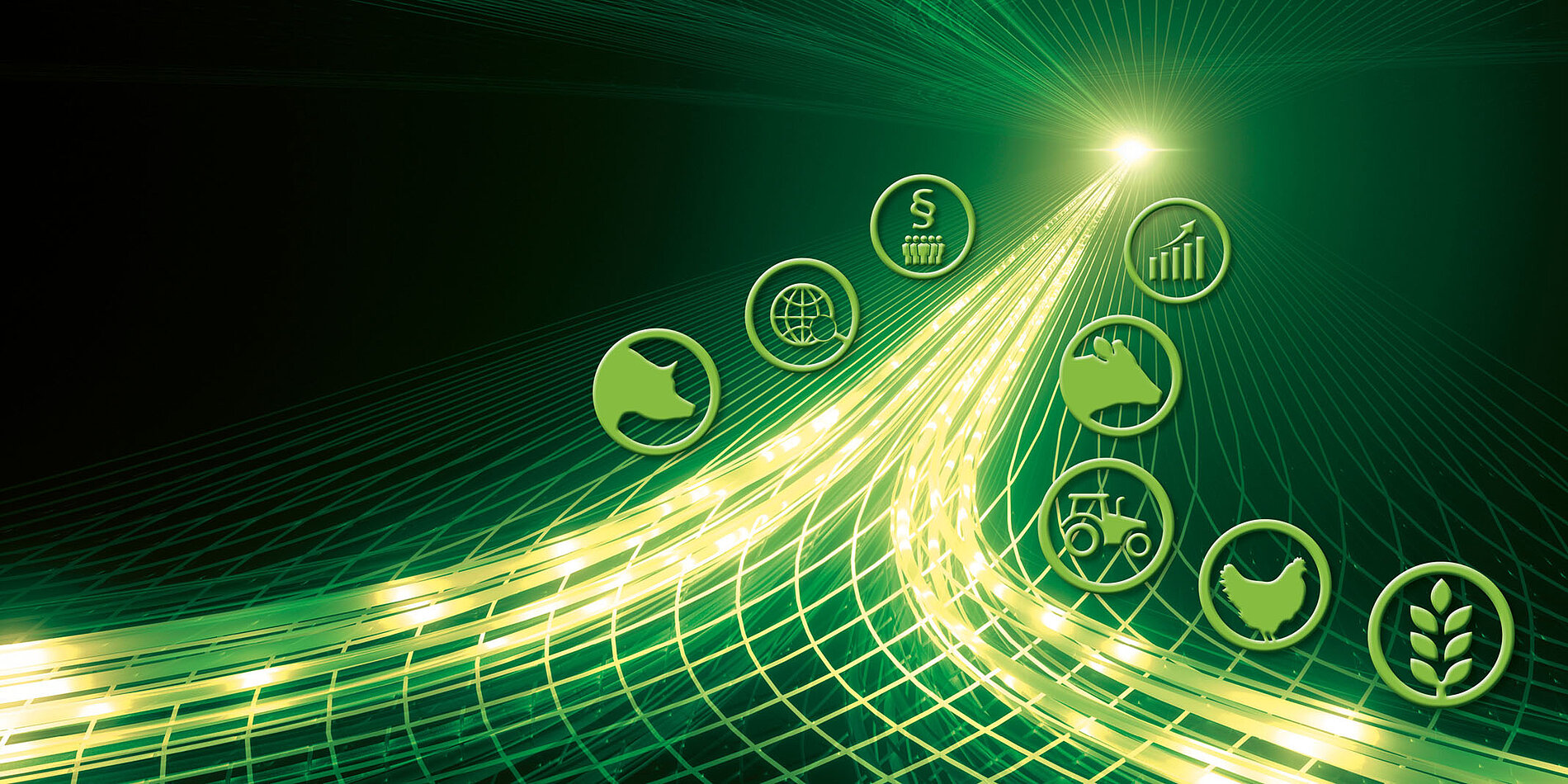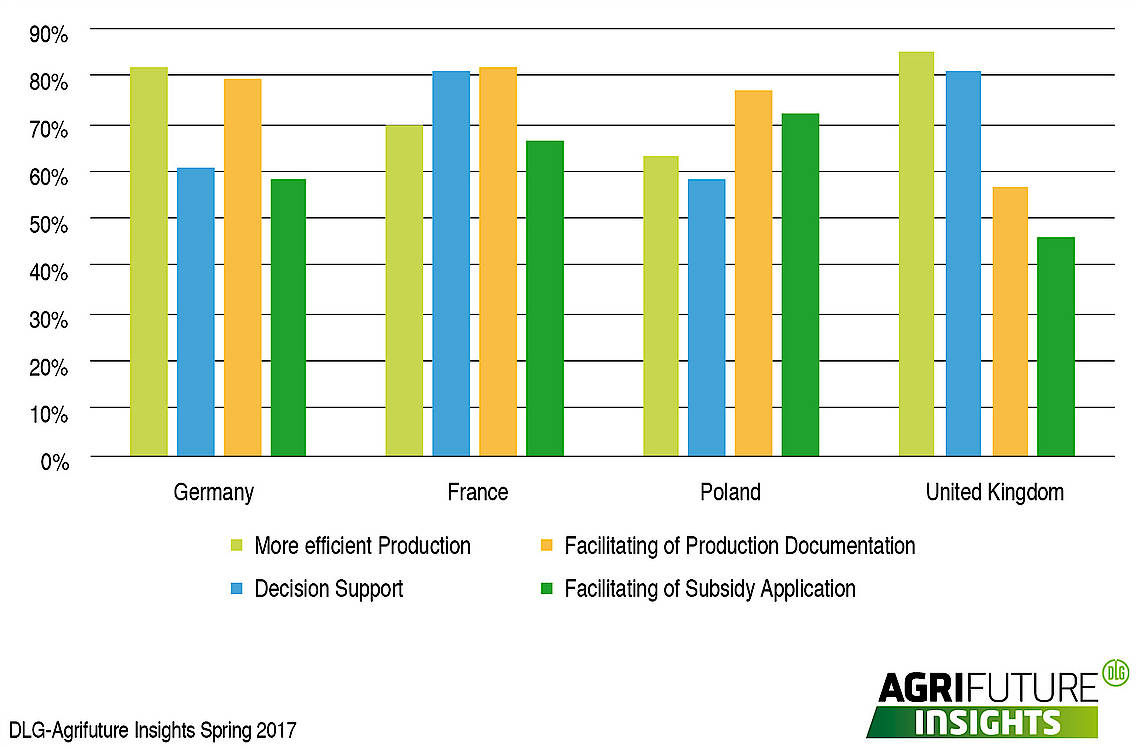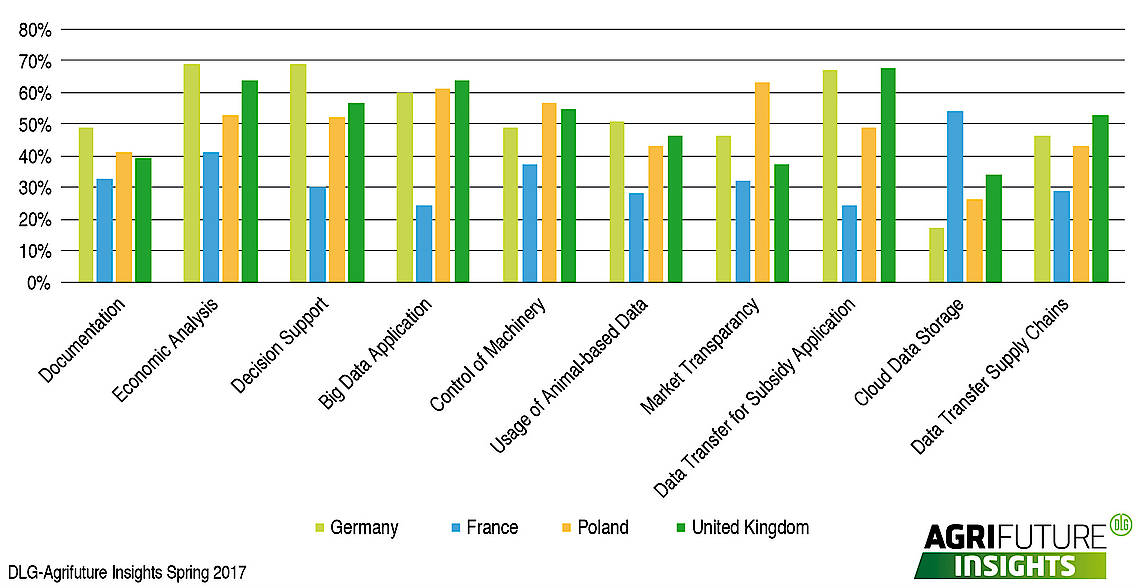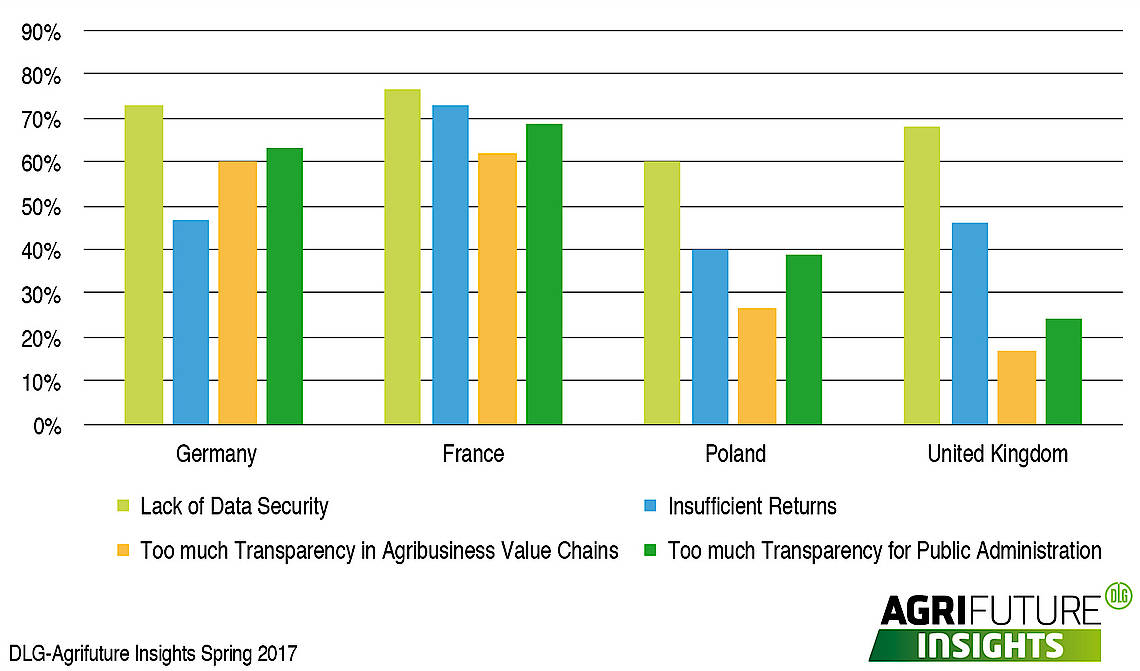Digital Agriculture - Opportunities. Risks. Acceptance.
A DLG position paper

Authors:
- DLG Committee for Digitization, Work Management and Process Technology
- DLG Committee for Technology in Crop Production
- DLG Committee for Technology in Animal Production
- DLG Work Group Information Technology
- Professor Dr. Hans W. Griepentrog, University of Hohenheim (lead management)
- Dr. Norbert Uppenkamp, Chamber of Agriculture North-Rhine/Westphalia
- Roland Hörner, DLG e.V., Competence Center Agriculture
1. Introduction
Probably no other innovation is spreading through all aspects of agriculture as massively as digitization just now, and accordingly it is a topic of intensive discussion.
Given the rising demand from a growing world population, agriculture as the basis of all primary production is faced with great challenges. As the largest user of land, the sector is also highly responsible for maintaining important environmental goods such as soil, water, climate and biodiversity.
There may be conflicts between the goals of food production and environmental conservation, so that it is particularly important at prime agricultural locations such as Germany to find conflict resolutions that are supported by broad consensus in society. There is a demand for new and progressive concepts that are adapted to the diversity of the different locations and strengthen competition. Digitization will assume a key role here. These concepts can help to maintain value creation in agriculture, integrate agriculture into vital rural areas and strengthen its profile as an indispensable part of society.
Digitization will change not only our entire business life, but also our social relations. Independently of the structure and size of a farm, various new digital and analog tool combinations are now appearing as an opportunity to actively join in shaping and supporting a style of agriculture fit for the future. For the agricultural sector it is all the more important to clearly define, articulate and insist on all the digitization requirements resulting from its special responsibility.
Digitization in agriculture offers many opportunities, but given the extensive networking and system formations it also involves risks. That is why it must be applied carefully so that agricultural production as the essential basis of the legally anchored “Critical Infrastructure Food” (Food Security Act (EVG)) remains assured, even if digital systems should fail for a time or maybe for somewhat longer – for example as a result of sabotage. Measures to secure decentralized emergency operation of the mounted and machine controls are therefore in the interest of society as a whole.
DLG’s requirements for digitizing in agriculture
- Expand infrastructure for mobile telecommunication! Availability is insufficient in many regions. This endangers all rural areas, obstructs all branches of industry located there and hinders the development of agriculture.
- All farm data belong to the farmer! The farmer has data sovereignty and is responsible for data security. Authorization, monitoring, control and transparency must be ensured. Digital watermarks in data sets and data coding are now ready for practical use and offer protection against unauthorized transfer, processing and analysis.
- Expand data protection and data security and protect agricultural operating and business data! Agriculture is not a “transparent operation”. Business data are initially business secrets, as they are in other sectors as well. For this, statutory data protection must be extended beyond personal data protection to cover farm, machine and business data too. The digital recording of all production processes on farms initially serves the farmer. Public authorities or third parties do not have any general right to inspect these data, but it is equally clear that farmers must comply completely with all statutory documentation and information obligations. Decentralized and redundant system structures should be strengthened here. They increase security against criminal attacks and in the case of defects. This will minimize data losses and allow production to continue even if digital systems fail temporarily.
- Farmers must be able to benefit from business with their data! For this it is important to prevent uncontrolled transfer via data platforms to Cloud systems. Such digitizing of agriculture could have a disruptive effect and threaten the livelihoods of farms. If data monopolies were to emerge, they would be counterproductive to economic participation by agriculture. That is why clear rules that allow competition here too must be created for this.
- Create transparency in Big Data analysis! Although Big Data contradicts the virtue of data economy, it is expedient when (and only when) the users of digital communication platforms authorize sharing of their data for the purpose of analysis and profit from the information gained this way.
- Make public and official data available free of charge! Collection and archiving of such data are financed through taxes. Weather data, land register data, soil data, route networks etc. should be made available as open data in standardized data formats suitable for practical use via interfaces. An expedient approach to this would be to provide a central data portal.
- Use digitizing to bring agriculture and consumers closer together! Digitizing simplifies transparency of production methods and traceability – this creates confidence and enhances appreciation of agriculture.
- Intensify basic and further training! Digitizing presupposes qualification. Farms can only make their way with well trained staff. Digital technologies and their application must have a firm place in the curricula.
2. Agriculture today
Agriculture differs fundamentally from industrial production. Unlike most industrial production processes, the farmer is always involved with living plant and animal organisms. Agriculture is characterized by complex and dynamic production conditions (for example weather and climate), which can cause disruptions, are difficult to predict and can only be controlled to a limited extent.
As the largest user of land, agriculture shapes the landscape and public spaces. There is consensus in society that modern and sustainable agriculture is to be acknowledged and conserved as a cultural achievement with its diverse functions ranging from production, living space and habitats, to recreation and aesthetics.
Productivity in agriculture has so far increased extremely quickly and to a much greater extent than in many other sectors. Whereas for example around the year 1900 a German farmer could only secure food supplies for a few persons, today he supplies over 140 consumers. However, during the same period consumption of resources also increased.
Digitally-assisted agricultural machines and equipment are already in use in arable farming and animal husbandry. Examples in field operations include self-steering machines, application equipment with variable dosing for fertilizers and plant protection agents, as well as automatic yield mapping for combine harvesters. In animal husbandry too, robots have long since been providing support in milking, feeding and manure removal. Furthermore, sensors, databases and various digital auxiliary tools help farmers in their daily herd management tasks.
That is why the aim in agriculture is to manage productively, efficiently, sustainably and in an environmentally friendly manner. This means converting farm inputs purposively and with low losses into yield and high product quality, above all in the barn and on the field, with the least possible impact on the environment.

Farmers from Germany, France, Poland and the United Kingdom assess more efficient
production as a top opportunity offered by the digitizing process. Farmers also see opportunities presented by digitizing in the simplification of farm documentation.
3. Opportunities for digital agriculture
Digitization creates many and diverse opportunities for the agricultural sector and its partners in the upstream and downstream sectors. This applies in particular for food processors, traders and consumers. It allows and simplifies both documentation and transparency as well as traceability for the processes along the entire value creation chain.
A survey conducted among farmers from Germany, France, Poland and the United Kingdom for “DLG-Agrifuture Insights” in spring 2017 showed that altogether the simplification of farm documentation and the improvement of production efficiency are perceived as top opportunities (Fig. 1). The assessment varies slightly in the four countries surveyed. While in Germany the focus is chiefly on efficiency and documentation, in France documentation and decision-making support top the list. Poland is hoping for the best effects in documentation and submission of applications, and the United Kingdom puts its trust in efficiency and decision-making support.
Digitization can mean additional value creation for farms together with promotion of rural areas. It can contribute to improving environmental kindliness, animal welfare and sustainability in farming.
The instruments set out above can be divided between a number of different headings – Precision Farming, Smart Farming and – integrating both of these – Digital Farming.
Precision Farming is understood to mean optimizing growth conditions by means of sensory analysis and precise application technology. Smart Farming is the further development of Precision Farming and contributes chiefly to supporting decision-making, as information processing has become increasingly complex due to data fusion and analysis and can only be mastered using partial or complete automation.
Digital Farming is understood to mean consistent application of the methods of “Precision Farming and Smart Farming”, internal and external networking of the farm and use of web-based data platforms together with Big Data analyses. Accordingly digitization provides modern methods for achieving comprehensive collection, storage, linking and evaluation of farm and production data. In particular it can help – particularly through data fusion and analysis in conjunction with Big Data methods – to improve the typically complex agricultural decisions on optimizing by supplying hitherto unavailable information. Cross-farm comparisons through external networking also appear expedient for certain aspects. This would release potential that has so far remained locked for increasing resource efficiency and environmental conservation. External networking of the farm also offers new opportunities, as farmers can draw on data from suppliers, customers and service providers, such as for example product lifetimes and stability times, the origin of feedstuffs etc. Cross-farm networking could also lead to lower-cost procurement of farm inputs so that farms can produce more cost-effectively.
Not even in the foreseeable future will it be possible to master processes in nature such as weather conditions or biotic and abiotic factors in agricultural production by means of Big Data and digitization. However, in the near future of digital farming farmers should be able to respond better to these unforeseeable effects through greater use of sensory analysis within the context of the ‘Internet of Things’ or remote sensing data. The dependence of agriculture on weather conditions remains an uncertainty, however, even with the help of digitization and correspondingly improved forecasts.
Digitization is manifested on the farms in the use of numerous digital tools. The “DLG-Agrifuture Insights” survey of 600 farmers in August 2017 revealed that profitability analysis tools enjoy top priority (Fig. 2). They are followed at a short distance behind by applications for machinery control, for Big Data analyses and for transferring data to public authorities. The most-used instruments in the four countries differ strongly. Germany favours profitability analyses. France enjoys a strong affinity with Cloud Computing, while Poland accords a high status to Big Data analysis and British farmers rate data transfer to public authorities highly.
The digital infrastructure must ensure data security and data protection. Mobile telecommunications, broadband internet, data platforms and data processing represent indispensable tools for digitization. Here decentralized and redundant system structures are to be preferred in order to minimize the risk of data loss and take preventive action against criminal attacks from the exterior. When using digital techniques, it must be ensured that production can be continued safely even if digital communication systems should not be available from time to time. That is why largely decentralized communication and data structures should be pursued.

The profitability analysis, support in decision-making and data transfer in connection with submitting applications enjoy top priority among farmers in Germany when it comes to using digital tools.
4. Digital tools
Data security makes it possible to code authorized data so that they can only be read by the addressees. Coding techniques are being constantly developed further and are available for practical use. However, so far they are not used sufficiently or consistently enough.
Data protection addresses the creation and safeguarding of scope for allowing new developments in information technology. Today it is also technically possible to create digital watermarks in data sets that mark transferred data and aim to protect them from unauthorized processing and analysis. Data sovereignty over all farm data as well as responsibility for data security must lie primarily with the farmer.
Internet-based software for data management such as electronic field plot files or herd management programs plays a significant role in digitizing. In future these systems will be at the centre of all manual and automated processes, and ensure forward-looking farm management through Farm Management Information Systems (FMIS).
Big Data analyses are new and becoming ever more important in data management. Big Data is understood to mean the analysis of large and heterogeneous amounts of data by means of mathematical algorithms. Big Data makes it possible to generate new and meaningful information from private and public volumes of data that have so far not been linked with each other. However, digitizing means re-thinking in data management as practised to date. The virtue of data economy contradicts the principles of the Big Data analysis. Users can share their authorized data via digital communication platforms and also issue orders to service providers for paid analyses.
Public and official geodata should be made available free of charge to agricultural stakeholders - e.g. extensive, detailed and above all up-to-date weather data, land register data, soil maps using relief, water holding capacities, route networks etc. In order to be able to use the data for cross-manufacturer applications, the data should be provided via interfaces in standardized data formats suitable for practical use as open data. An example of this is the current standard ISO 11783 (known as ISOBUS), although this requires continuous further development. Another expedient approach consists in providing a central data portal.
In many regions digitizing of agriculture fails due to the lack of a nationwide and efficient infrastructure for mobile telecommunication. Swift expansion of such infrastructure is crucially important, not only for agriculture but also for the development of all branches of industry and the economy, and hence for society as a whole in rural areas.

Farmers see the risks in digitizing to lie in the lack of data security. Especially farmers in France see only insufficient operational benefit in digitizing so far.
5. Risks of digitizing
There are two sides to every medal. When asked about the risks of digitizing, the altogether 600 farmers surveyed, especially those in France, the United Kingdom and Poland, stated a lack of data security and uncertain amortization of investments in digitizing. German farmers complained above all about the lack of data security and excessive transparency vis-à-vis the public authorities.
If in future farms can record and present their production methods digitally and transparently, this should not mean that public authorities or third parties have a general right to access these data (“transparent farms”). The farmers should be set on an equal footing with other economic operators whose operational and business data are recognized as worthy of protection. However, wherever there is a statutory obligation to provide documentation and information, farmers must comply with this in full.
Future data protection should not only concern personal data, but be expanded to cover operating and business data as well. As a matter of principle operating and machine data belong to the farmer. Authorization, monitoring and transparency must be assured in connection with each data transfer.
However, a prerequisite for greater transparency in data transfer would be that all data streams as well as their use are always revealed. At present only personal data are protected by law. The legal frameworks need to be adapted to secure data protection for business and operating data too. Clear rules extending as far as exclusion of data monopolies must be created in order to counteract the hazards and risks.. In future data will become a tradable commodity and its economic significance will increase enormously.
The possibility of using digitizing in agriculture as a disruptive innovation should be prevented. The farmers’ site-specific knowledge and skills should not serve uncontrolled via data platforms in Cloud systems as an information base for third-party business models from which the farmer does not benefit. In this way digitizing of agriculture would be disruptive and endanger the livelihood of farms.
6. Acceptance in society
Sustainable agricultural production is of extremely high importance for food security. It should be ensured that it takes economic aspects into account on an equal footing with ecological and social aspects. Digital farming can bring consumers and farmers closer together. With simplified and more comprehensive opportunities for food traceability, knowledge about and appreciation of agricultural production and foods can be enhanced further.
With digitizing, the demand for qualified expert staff with appropriate skills will increase. Continuing training and education for staff remains important in order to maintain farms sustainably. Within the framework of basic and further training and consultancy, special and intensive attention should be paid to digital technologies and their use.
7. Conclusion
Productive, sustainable and fail-safe agriculture makes rural areas fit for the future and promotes their vitality. This differs from industrial production because it makes particularly strong use of natural resources and is exposed to changing climate conditions at widely varying sites. It requires site-appropriate approaches oriented to ecological, economic and social standards.
Digitizing represents progress for agriculture when it maintains the entrepreneurial autonomy of farmers. It should strengthen and expand the role of agriculture at the centre of society that has developed over the centuries. Mankind should always be at the heart of developments, supported by technology which facilitates the performance of work and improves the results of human actions.
